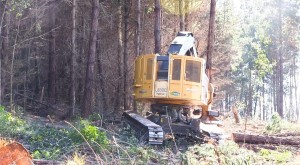— Paul Iarocci
Between two pine crews, Hobart, Tasmania based B.R. & K.F. Muskett & Sons supply the Norske Skog Boyer mill with nearly a quarter of its weekly intake. Built in 1941 and originally owned by Australian Newsprint Mills Pty Ltd., it was the first mill in the southern hemisphere to make paper from eucalyptus fibre. It has only had three owners in its 75 year history. The Muskett’s – fourth-generation loggers operating a 50-year-old family business – are closely tied to the mill.
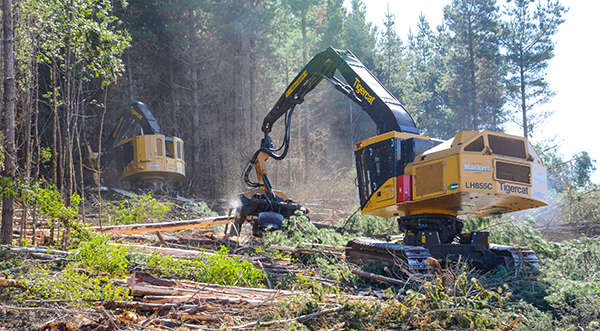
The LH855C harvester operated by Matthew Muskett follows the L830C, piloted by Andrew Muskett. The large pine is processed infield and forwarded to roadside.
BTB caught up with Kevin Muskett and sons, Matthew and Andrew, last October where one of the pine crews was working a radiata site and producing around 2 000 m³ (approximately 2,000 tn) per week with a Tigercat L830C feller buncher, an LH855C harvester and a 1075B forwarder. Kevin’s sons Matthew and Andrew operate the LH855C and L830C as well as being responsible for running the operation. They can maintain production with the three machine system if the piece size is greater than 1,5 tonne. “In poor timber we will bring in a second harvester,” explains Kevin.
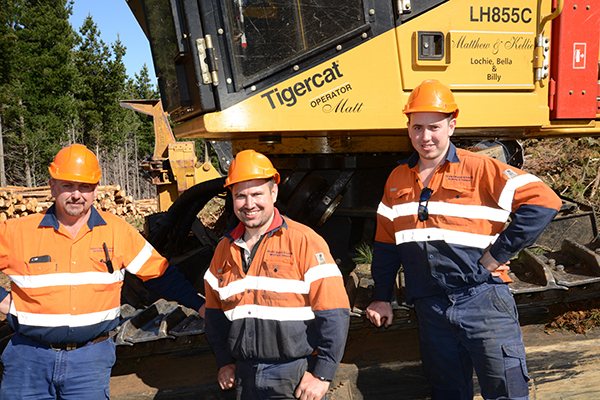
(L-R) Kevin, Matthew and Andrew Muskett.
The company purchased the three Tigercat machines as a complete system, breaking away from the Komatsu gear that they have traditionally run. “The Tigercats are good machines and we get good support from Dave’s crew at Onetrak,” says Kevin. “We have an L870C buncher and an H855C harvester on the other pine operation,” Kevin adds. This crew is managed by Kevin’s brother Geoffrey who doubles as the L870C operator. Geoffrey’s two sons also work on the crew. Nicholas is on the Tigercat H855C and Cassidy operates the loader. The company also runs two hardwood sites and twelve haul trucks.
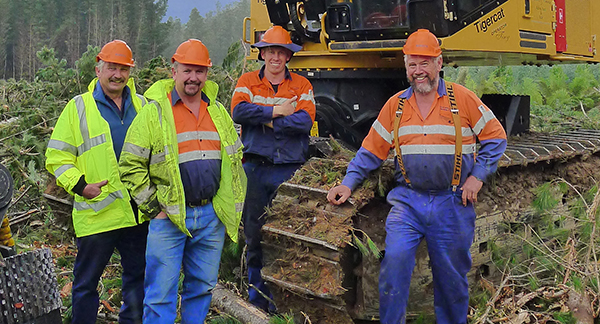
(L-R) Robert, Kevin, Nicholas (Tiny) and Geoffrey Muskett.
Geoffrey routinely deals with some highly challenging working conditions in the Florentine Valley in southwest Tasmania where limestone sinkholes litter the 30-year-old pine plantations. He works closely with the Forestry Practices Authority and Norske Skog who map and mark every sinkhole. Muskett & Sons was recognized in 2015 with an award for exemplary performance related to the sinkholes and shovel logging on steep slopes.
The company has never owned a forwarder
with the lifting capacity and stability of the 1075B.
We are very happy with it.
– Kevin Muskett
Kevin continues listing family members. “My brother Robert supervises the workshop and my sister, Helen, manages the office and Brian and Kath are my parents.” The company has approximately 50 employees in total.
Hot logging
The major challenge of the pine operations is that the wood can’t stand at roadside for more than two weeks. According to Kevin, the ability to meet just in time harvesting and delivery requirements is highly dependent on machine availability. “Reliability of the gear and planning is very important. The buncher can’t get very far ahead of the rest of the system or the wood will sit on the ground too long and we can’t stockpile at roadside for too long, so everything has to be working with a very high availability rate.”
Kevin acknowledges that the Tigercat machinery is very productive. For instance, the company has never owned a forwarder with the lifting capacity and stability of the 1075B. “We are very happy with it,” confirms Kevin.
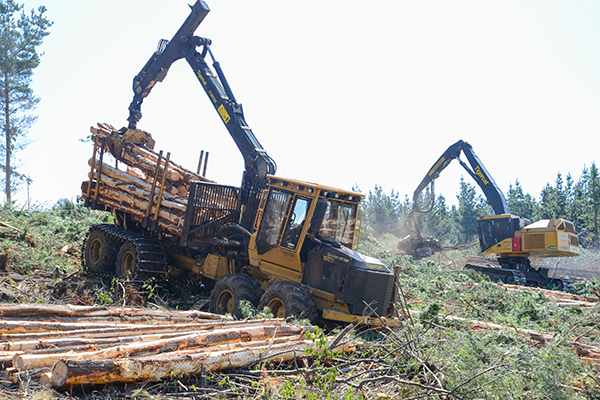
The Tigercat 1075B with the LH855C in the background. Running a three machine system in a hot logging scenario requires confi dence in the gear and high machine availability according to Kevin Muskett.
The Tigercat 1075B with the LH855C in the background. Running a three machine system in a hot logging scenario requires confidence in the gear and high machine availability according to Kevin Muskett.
Typically, the terrain is steep and rocky. “The LH855C does a bit of shovelling on steep ground,” explains Kevin. Although it slows the production rate for processing, it improves the efficiency and balance of the overall operation. “We track up the forwarder when it gets really steep.” And when it gets really, really steep, the L830C will fell for a yarder.
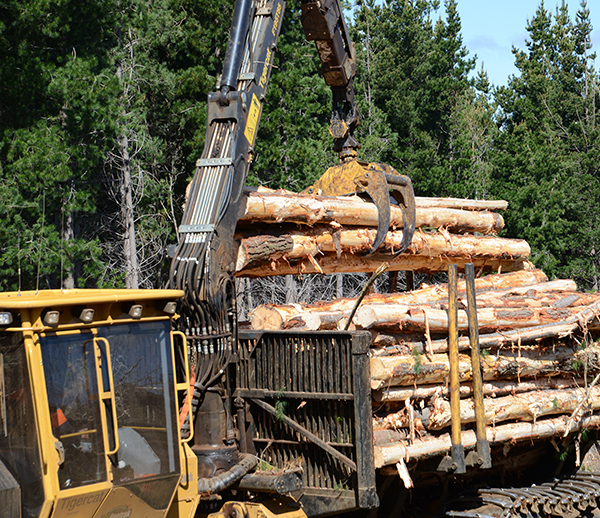
The powerful Tigercat crane and large capacity Tigercat grapple adds to the productivity of the 1075B.
Kevin says that Muskett & Sons just recently renewed the mill contract and Norske Skog seems to be doing all the right things to guarantee future success in a state where the vast majority of the fibre is destined for export. The mill turns out two grades of newsprint as well as high quality glossy paper for magazines, which turned out to be a bit of a saviour. Kevin explains that Norske Skog completed the capital investment project two years ago. Faced with a shrinking market for newsprint in Australia, volatile Asian markets and a strong Australian dollar, the company spent $84 million (AUD) to convert one of the mill’s paper machines to produce high quality glossy paper for magazines. This represents one of the first new major investments in the Tasmanian forest industry in some time. So these days Kevin is feeling good about his business, his major customer and the general health of the industry.







